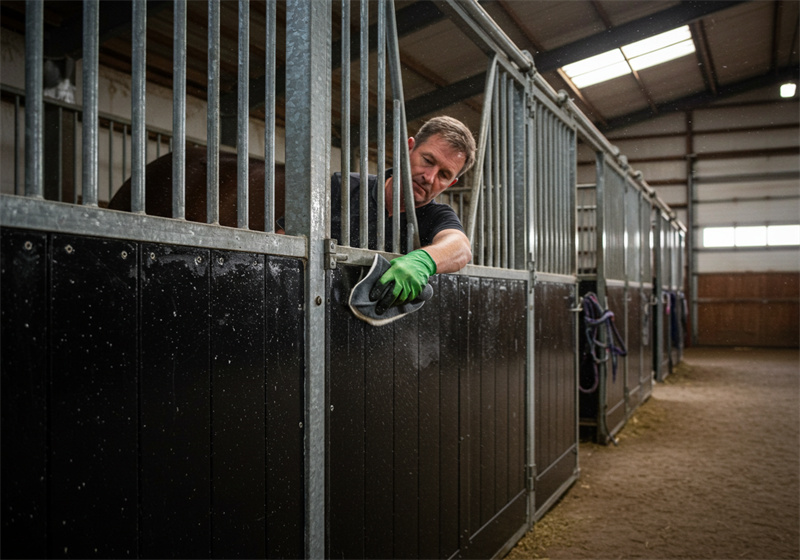Choosing the right horse panels for your Australian commercial operation isn’t just about keeping horses contained—it’s about protecting your investment, ensuring animal safety, and avoiding costly liability issues. This comprehensive guide breaks down the three critical factors every professional should consider: superior galvanization processes that actually protect against rust, structural engineering that won’t fail when horses push against panels, and horse-specific safety features that prevent injuries. We’ll also show you how to apply Australian safety standards to create installations that can handle everything from coastal salt spray to high winds at outdoor events.
The Complete Guide to Professional Horse Panels: Australian Commercial Standards and Safety Requirements
When you’re running a commercial horse operation in Australia, every piece of equipment matters. But horse panels? They’re absolutely critical. A single panel failure can mean injured animals, escaped horses, damaged reputation, and serious liability exposure. Yet too many operators still treat panel selection like buying any old livestock fencing.
Here’s the reality: generic livestock panels aren’t built for horses. They lack the safety features, structural integrity, and corrosion protection that Australian conditions demand. This guide will teach you exactly what separates professional-grade horse panels from cheap alternatives. You’ll learn why the galvanization process matters more than price, how proper welding prevents catastrophic failures, and which design elements actually keep horses safe. Most importantly, we’ll show you how to apply Australian safety standards to ensure your temporary and permanent installations can handle whatever nature throws at them.
Galvanization Science: Why Your Panel Choice Determines Long-Term Value
The difference between panels that last decades and those that rust out in a few years comes down to one critical process—and most suppliers are cutting corners here.
Hot-Dip Galvanization: The Only Real Protection for Australian Conditions
Hot-dip galvanization isn’t just a coating—it’s a chemical marriage between zinc and steel. When a finished panel gets dunked in molten zinc at 840°F, the metals actually bond at the molecular level. This creates multiple layers of zinc-iron alloys that form an incredibly tough protective shell around every inch of steel.
What makes this process so effective is zinc’s sacrificial nature. When a panel gets scratched down to the steel, the surrounding zinc literally sacrifices itself to protect the exposed metal. It corrodes first, buying your steel years of additional protection. This active defense system is why quality galvanized horse panels can last 20+ years in harsh Australian conditions.
The Pre-Galvanized Trap: Why Cheaper Panels Fail Fast
Walk into any rural supply store and you’ll see plenty of “galvanized” panels at tempting prices. But here’s what they won’t tell you: most cheap panels use pre-galvanized tubing. The steel gets galvanized before it’s cut and welded into panels. Every cut burns off the zinc coating. Every weld destroys the protection.
Those exposed welds become rust magnets. In coastal areas or high-rainfall regions, you’ll see rust bleeding from every joint within 2-3 years. The panels might look fine from a distance, but the structural integrity is already compromised. Hot-dip galvanization happens after fabrication, so every weld, every cut, every corner gets full zinc protection.
Reading the Numbers: Zinc Coating Thickness and Real-World Performance
Zinc coating thickness is measured in grams per square meter (g/m²), and this number tells you everything about a panel’s lifespan. Thin coatings fail fast. Heavy coatings last decades.
Premium European-made stable panels often feature coatings exceeding 450 g/m². That’s serious protection, especially for Australian coastal operations where salt spray accelerates corrosion. Compare that to cheap pre-galvanized panels that might have 275 g/m² or less—and remember, that coating is already compromised at every weld. When suppliers quote coating thickness, always ask if it’s post-fabrication hot-dip galvanization.
Engineering That Works: How Professional Panels Handle Real-World Stress
A 1,200-pound horse hitting a panel at full speed will find every weak point in seconds—here’s how proper engineering prevents catastrophic failures.
Rail Profiles: Why Shape Matters for Safety and Strength
Oval rails are the gold standard for horse containment. Their smooth, rounded profile deflects impact instead of concentrating it. When a horse runs into an oval rail, the force glances off rather than creating a sharp impact point. This reduces injury risk and prevents the concentrated stress that can bend or break rails.
Square and rectangular rails (RHS) offer excellent strength-to-weight ratios and are popular for commercial applications. Round rails work for light-duty situations but can create catching points where a hoof might get trapped between the rail and an adjacent surface. Whatever profile you choose, steel gauge matters enormously. Thicker walls resist deformation under the massive forces horses can generate.
Weld Quality: The Difference Between Professional and Amateur Construction
Here’s where you separate professional panels from yard sale quality: the welds. Every connection point where a rail meets an upright should feature a complete 360-degree weld. This creates a rigid joint that prevents the panel from racking or twisting under stress.
Tack welds—those little spot welds you see on cheap panels—are accidents waiting to happen. When a panicked horse hits the fence, those weak joints snap. The panel deforms, creating sharp edges and escape routes. Professional-grade panels cost more partly because proper welding takes time and skill. But it’s the difference between a fence that holds and one that fails when you need it most.
Connection Systems: Lugs, Pins, and Stability Features That Actually Work
Panel connections determine whether your fence stays up or falls over. Heavy-duty lugs with proper spacing create secure links between panels. Double-lug systems—lugs at both top and bottom—provide superior stability compared to single-lug designs that can pivot and fail.
The connecting pins matter just as much. Tight-fitting drop pins stay secure even when horses push against them. Loose pins can be lifted out by curious muzzles or rattled free by movement. Panel feet are often overlooked but crucial for stability. Without proper feet, panels sink into soft ground, compromising the entire fence line. Well-designed U-shaped feet distribute weight and keep panels level on uneven terrain.
| Rail Type | Horse Safety Rating | Structural Strength | Cost Range |
|---|---|---|---|
| Oval Rails | Excellent | Excellent | Premium |
| Square/Rectangular | Good | Excellent | Moderate-High |
| Round Rails | Fair | Good | Budget |
Horse-Specific Safety: Design Elements That Prevent Injuries
Cattle panels might contain livestock, but they’re death traps for horses—here’s what horse-specific design actually means and why it matters for your liability.
Rail Spacing: The Critical Measurements That Prevent Trapped Limbs
This is where using cattle panels for horses becomes dangerous. Cattle panels have wide gaps between rails—perfect for a horse’s leg or head to slip through. Once trapped, horses panic. They fight the restraint, often causing severe injuries or even breaking bones trying to escape.
Horse-specific panels follow a “no-climb, no-trap” design philosophy. Rail spacing is calculated to prevent any part of a horse’s body from getting caught. Many quality panels use graduated spacing—narrower gaps at the bottom where legs are most likely to probe, wider spacing higher up. Always measure the gaps and think about whether a hoof, pastern, or head could get stuck.
Surface Quality: Why Smooth Finishes Prevent Cuts and Scrapes
Horses have sensitive skin and a talent for finding sharp edges. Every surface on a horse panel should be smooth and forgiving. This means deburred cut edges, rounded corners, and smooth welds. Rough or jagged welds can slice skin when horses rub against panels.
Uncapped posts are particularly dangerous. They create sharp, hollow edges that can cause deep cuts. Premium panels cap every post end. Some manufacturers add powder coating over galvanization in a duplex system. This creates an ultra-smooth surface while adding another layer of corrosion protection and allowing for custom colors.
Security Features: Keeping Horses In and Hardware Intact
Horses are escape artists. They’ll test every latch, lift every pin, and push every weak point. Drop pins need to be designed so they can’t be easily manipulated by a curious muzzle. Some pins feature retention clips or require a specific lifting motion that horses can’t replicate.
Gate latches require special attention. They must be easy for humans to operate—even with one hand while holding a lead rope—but complex enough that horses can’t figure them out. Look for latches that require multiple motions or are protected by guards that prevent horse access.
Durable Portable Horse Stables Built for Safety and Ease
Explore robust, customizable horse stables crafted with premium HDPE infill and corrosion-resistant steel. Designed for easy transport and assembly, DB Stable’s solutions ensure secure, practical shelter for every equestrian need.

Australian Standards Applied: Using AS 4687:2022 Principles for Commercial Horse Operations
The new Australian temporary fencing standard provides a blueprint for assessing wind loads and stability risks that smart operators are already applying to horse panel installations.
Wind Load Management: When Horse Panels Become Dangerous Sails
AS 4687:2022 introduced rigorous wind load calculations for temporary fencing, and these principles apply directly to horse panel installations. A large array of panels can catch wind like a giant sail. Add shade cloth, banners, or tarps and you’ve created a structure that can generate enormous overturning forces.
This becomes critical for temporary installations at shows or events. A fence line that seems stable in calm conditions can become dangerous in wind. The standard provides calculation methods for determining when additional bracing, anchoring, or footings become necessary. For exposed locations or installations with wind-catching attachments, you need to think beyond simple panel-to-panel connections.
Risk-Based Selection: Matching Panel Specifications to Application Severity
The standard promotes risk-based decision making—choose your specification based on the consequences of failure. This thinking revolutionizes how smart operators select horse panels:
- Low-Risk Applications: Small supervised round yards with minimal public access. Standard commercial-grade panels with good galvanization and proper welding are sufficient.
- Medium-Risk Applications: Temporary stabling at regional shows with moderate public exposure. Heavy-duty panels with secure connections and documented stability planning become important.
- High-Risk Applications: Public-facing quarantine facilities or large multi-day events in exposed locations. Maximum specification panels with engineered wind load calculations and documented safety protocols become essential.
This approach helps you invest safety dollars where they matter most while avoiding over-specification for low-risk applications.
Documentation for Liability Protection: Creating Your Safety Paper Trail
Commercial operators face increasing liability exposure. Documenting your panel specifications and selection rationale creates a powerful defense. Keep records showing you specified panels based on established safety principles. Document the galvanization type, weld quality, steel specifications, and any stability calculations.
In case of an incident, this documentation proves you made informed, professional decisions to create a safe environment. It shifts the conversation from “why didn’t you do more?” to “here’s the professional standard we followed.” For insurance and legal purposes, this documentation can be invaluable.
Smart Buying: Your Professional Panel Selection Framework
Armed with the right questions and evaluation criteria, you can separate real quality from clever marketing—here’s your buying checklist.
Horse Panels vs. Cattle Panels: Why the Difference Matters
Using cattle panels for horses is penny-wise and pound-foolish. The rail spacing alone creates unacceptable injury risk. Cattle panels also typically use lighter construction since cattle are generally less reactive and destructive than horses. Horse panels are built taller to discourage jumping and feature smoother finishes to prevent injuries.
The cost difference is real but small compared to potential veterinary bills or liability exposure. Cattle panels might save money upfront, but they can cost far more in the long run.
Essential Questions Every Supplier Must Answer
Use these questions to evaluate any potential supplier and separate professional-grade products from cheap alternatives:
- Is hot-dip galvanization performed after complete fabrication?
- What is the guaranteed minimum zinc coating thickness in g/m²?
- Are all rail-to-upright connections fully welded 360 degrees?
- What gauge steel is used for rails and uprights?
- What are the exact rail spacing measurements from bottom to top?
- Are all tube ends and posts fully capped with no sharp edges?
- What foot design prevents sinking in soft ground?
- How are connection pins designed to prevent horse tampering?
- What warranty covers rust formation, specifically at welds?
- Can you provide engineering specifications or commercial case studies?
Total Cost Analysis: Understanding Real Return on Investment
Cheap panels cost more than expensive ones when you factor in replacement cycles, injury risk, and liability exposure. A pre-galvanized panel might need replacement in 3-5 years due to weld rust. A quality hot-dip galvanized panel can last 20+ years.
Calculate the hidden costs cheap panels invite: veterinary bills from sharp-edge injuries, repair costs from failed welds, liability exposure from escaped animals, and replacement costs when panels rust out prematurely. Quality panels aren’t an expense—they’re an insurance policy that pays dividends for decades.
Durable Portable Horse Stables Built for Safety and Ease
Explore robust, customizable horse stables crafted with premium HDPE infill and corrosion-resistant steel. Designed for easy transport and assembly, DB Stable’s solutions ensure secure, practical shelter for every equestrian need.

Selecting galvanized horse panels for your Australian commercial operation defines your commitment to professional standards. We’ve covered the three pillars that separate quality from compromise: superior galvanization science that actually prevents rust, structural engineering that withstands real-world forces, and horse-specific safety features that protect animals and limit liability. By applying these principles and demanding documentation from suppliers, you create installations that protect your horses, your staff, and your business reputation. The choice between cheap panels and professional-grade equipment isn’t about budget—it’s about understanding that quality infrastructure is the foundation of successful horse operations.
Ready to upgrade your facility with panels that meet professional standards? Contact our equine infrastructure specialists for a free consultation on your specific project requirements and see the difference quality engineering makes.
Frequently Asked Questions
What are the standard dimensions for commercial horse panels in Australia?
Most commercial operations use panels measuring 1.8m high by 2.1m long. This height effectively deters jumping while the length provides good stability without being unwieldy. Custom dimensions are available for specific applications, but these standard sizes work well for most temporary and permanent installations.
How long do quality galvanized horse panels last in coastal Australian conditions?
Panels with heavy hot-dip galvanization (450+ g/m²) typically last 15-25 years or more, even in salt-spray environments. Pre-galvanized panels often show significant weld rust within 2-5 years in the same conditions. The coating thickness and application method make an enormous difference in coastal longevity.
What makes horse panels different from cattle panels beyond height?
Rail spacing is the critical difference. Cattle panels have wider gaps that create trapping hazards for horse legs and heads. Horse panels also typically feature smoother finishes, heavier construction, and better connection systems designed for more reactive animals that test boundaries more aggressively than cattle.
Are heavier panels always better for commercial applications?
Not necessarily. While heavier gauge steel provides more strength, it also reduces portability for temporary applications. The ideal panel balances robust construction for safety with manageable weight for transport and setup. Consider your specific use case when evaluating the strength-to-weight ratio.
How do I calculate wind risk for temporary horse yards at outdoor events?
Assess site exposure and avoid adding shade cloth or banners in windy locations. Use heavy-duty panels with secure connections and add bracing or anchors at corners and long runs, especially on soft ground. For large installations, consider consulting with an engineer familiar with AS 4687:2022 wind load principles.
Can I add powder coating to galvanized panels for branding purposes?
Yes. Powder coating over hot-dip galvanization creates a duplex system that offers superior corrosion protection and attractive, customizable finishes. The powder coating should always be applied over the galvanized base, never as a substitute for galvanization. This combination provides the ultimate in both protection and aesthetics.
What maintenance do galvanized horse panels require?
Very little ongoing maintenance is required. Periodically inspect welds and connection points for stress signs. Washing panels to remove salt deposits extends galvanization life in coastal areas. The main maintenance involves checking hardware like pins and latches for proper operation and security.








